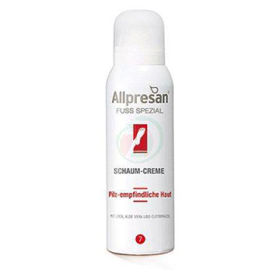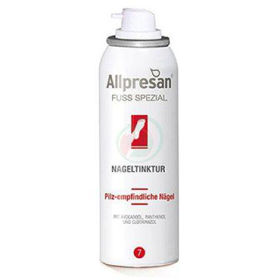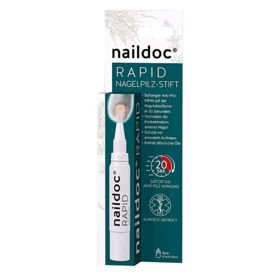Customer question:
Fungus on the legs - what are the symptoms? - question from an anonymous customer
Pharmacist's answer:
An athlete's foot is a fungal infection of the foot skin that usually starts between the toes. It usually occurs in people whose feet are often very sweaty (wearing closed-tight shoes).
Athletes' foot is closely related to other fungal infections such as ringworm and jock itch. It can be treated with antifungal medications, but the infection often returns. If you have diabetes or a weakened immune system and suspect you have an athlete's foot, contact your physician as soon as possible.
Athlete's foot can affect one or both feet, and common signs and symptoms are:
- scaly, peeling, or cracked skin between the toes
- itching, especially immediately after removing shoes and socks
- Inflamed skin that may look red, purple, or greyish
- dry, scaly skin on the bottom of the foot that extends upward
- burning or stinging sensation on the skin
- Blisters on feet
Fungi or other organisms that cause these types of infections are:
Tinea pedis
Tinea pedis is caused by the excessive presence of dermatophyte fungi. These fungi require keratin to grow and can cause skin, hair, and nail infections. Tinea pedis usually start developing between the toes. It can spread to the sides of the foot, sole, and heel of the foot. Sometimes, tinea pedis can occur with a fungal infection of the groin, hands, nails, or both.
Fungi that commonly cause tinea pedis to include:
- Trichophyton rubrum
- Epidermophyton floccosum
- Trichophyton interdigitale
While tinea pedis can occur in anyone, including children and the elderly, it usually occurs in men and young adults.
Other risk factors for tinea pedis include:
- footwear that covers the entire foot, such as heavy boots or sneakers
- certain medicines such as corticosteroids or medicines that suppress the immune system
- walking barefoot in public places such as changing rooms
- wearing socks with poor ventilation
- long-term exposure to water
- hot and humid environments
- excessive sweating
- diabetes
Tips for preventing these types of infections:
- wearing sandals or footwear in public places
- keeping feet dry
- washing your feet every day
- wearing socks made of natural fabrics
- changing the shoes, you wear every day
- don't share clothes or shoes with other people
To treat tinea pedis, the doctor often prescribes topical antifungal medications for more effective treatment. In particular, creams can be applied directly to the affected skin once or twice a day. The cream usually takes 2-4 weeks to start working, but it may work faster if the infection is mild.
If topical treatments don't work, your doctor may prescribe oral antifungal medications such as terbinafine or fluconazole. The treatment schedule and dose depend on the severity of the infection.
Onychomycosis
Onychomycosis can affect one or more toenails or fingernails. More often, onychomycosis affects the big and small nails.
The following organisms can cause onychomycosis:
- dermatophytes such as Trichophyton rubrum and T. interdigitale
- yeasts such as Candida albicans
- molds such as Scopulariopsis brevicaulis
Risk factors for onychomycosis include:
- older age
- untreated fungal infection
- hot and humid environments
- long-term exposure to water
- previous injury to the nail
- inflammatory nail diseases
- certain sports activities
- excessive sweating
- weakened immune system
- unsuitable footwear or socks with poor ventilation
- diabetes or psoriasis
- obesity
Tips to prevent this onychomycosis:
- wearing sandals or flip-flops in hot temperatures
- wear a clean pair of socks every day
- change your shoes every day if possible
- regular pedicure and nail clipping
- keeping feet dry and clean
- regular moisturizing of the skin around the nails and feet
Home remedies for onychomycosis include regularly washing the skin around the nails and keeping the feet quiet and dry. An older study found that treating onychomycosis with ointments such as Vicks VapoRub positively affected 83% of participants. In addition, your doctor may prescribe topical antifungal creams for mild infections, which include amorolfine and ciclopirox.
Antifungal tablets have a higher cure rate than topical creams and topical medications. They also work faster, so a person may only need to take them for a few months. However, the doctor may recommend removing the nail if the infection is more severe.
In the paragraphs below, you can read some of the most common questions and answers on fungal infection on the leg.
"Are there any home remedies for toenail fungus?" question from an anonymous customer
Vicks VapoRub Ointment:
Vicks VapoRub is a topical ointment designed to relieve coughs, but its active ingredients (camphor and eucalyptus oil) can effectively help treat nail fungus. A 2011 study found that Vicks VapoRub has a positive clinical effect in treating nail fungus. For this type of use, apply a small amount of Vicks VapoRub ointment to the affected area at least once daily.
You can make your purchase at the link below:
https://www.moja-lekarna.com/vicks-vaporub-mazilo-za-pomoc-pri-prehladu< /a>
Tea tree essential oil:
Tea tree oil, called Melaleuca in Latin, is essential. Twice a day, apply tea tree oil directly to the affected nail with a cotton swab, or apply it dermally as a cream to the fungal area.
You can make your purchase at the links below:
https://www.moja-lekarna.com/eteris-etericno-olje-bio-cajevec-10-ml< /a>
https://www.moja-lekarna.com/aromatica-cajevec-etericno-olje-10-ml< /p>
Bath with alcohol vinegar:
Mix 1 cup (240 mL) of warm water and (120 mL) of alcohol vinegar in a bowl. The bowl should be large enough for your foot to rest comfortably. Mix the water and alcohol vinegar well. You can also use apple cider vinegar instead of alcohol vinegar. Soak the foot for 10 - 20 minutes. Make sure the water covers the entire infected soil.
"Which pharmaceutical drugs are used to treat foot fungus?" - question from an anonymous customer
Oral antifungal drugs:
These medications are often the first choice, as they help the new nail grow without infection and slowly replace the infected part. This type of medicine is usually taken every day for 6 to 12 weeks; the weakness is that it works systemically and not just locally. Therefore, you will not notice the final result of the treatment until the new nail has fully grown. It may take four months or even more to clear the infection.
Medical nail polishes:
The doctor can give you advice or a prescription for antifungal nail polish. Usually, the instruction is to apply once daily to infected nails and the surrounding skin. After seven days, clean the accumulated layers with alcohol, then start with new applications. You may need to use this type of nail polish every day for almost a year.
Creams for nails:
Your doctor may prescribe an antifungal cream. Rub this product into infected nails after soaking. These creams may work better if you thin the nails first - this helps the medicine pass through the hard surface of the nail to the underlying fungal 'housing.'
"Can foot fungus be dangerous?" - question from an anonymous customer
Fungus on the feet does not cause serious health problems, but it usually does not go away alone. If the infection is not treated, it can spread to the nail and cause a fungal infection. The infection can also spread to other areas of the skin, such as the hands, but otherwise, this is much rarer.
"What happens if we don't treat foot fungus?" - question from an anonymous customer
If a fungal infection on your foot is not treated, it can affect the toenails - they can become thick, discolored, or split further - the fungus can even spread to your hands or groin. Additionally, a yeast infection can make you more vulnerable to bacterial infections such as cellulitis.
"Can I use vinegar to treat foot fungus?"- question from an anonymous customer
Vinegar is a diluted form of acetic acid, which is versatile and mostly harmless. Vinegar is used for cooking and cleaning, but it can also be used, among other things, for the care of infected feet - otherwise, this type of procedure is not very effective.
Soak with vinegar can provide positive results at bland in all forms of fungal infection of the legs.
Care procedure for infected feet with vinegar:
- fill the container with 1 cup of vinegar
- add 2 cups of warm water
- continue adding 1 cup vinegar and 2 cups warm water until the container is full
- soak your feet for 10 to 20 minutes
- repeat the process every day
Vinegar is safe to use when used in moderation. However, vinegar may only slightly irritate the skin, so do not use it on inflamed or damaged skin; it is also unsuitable for treating foot wounds. People with diabetes should avoid using vinegar for the foot above problems. Although diabetes can cause unwanted foot conditions, including warts and athlete's foot, it often requires specialist care.
Interesting reading: Fungus in the mouth
Interesting reading: How to eliminate nail fungus forum













